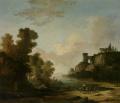| |
|
|
|
Ruins in art and painting Thomas Girtin (1775-1802) Rievaulx Abbey
Watercolor and pencil on paper, 1798 (41.91 x 55.88 cm)( 16,5 x 22 inch ) Victoria and Albert Museum, London
images: Public domain
Characteristic features of landscapes with ruins in paintings of the 17th, 18th and 19th centuries may be as follows: - 1. Romantic atmosphere: Landscapes with ruins are often imbued with mystery and melancholic mood, reflecting interest in the past and passing eras.
- 2. Symbolism of decline: Ruins serve as a symbol of time, change and loss. They may represent the ruins of ancient buildings or architectural structures that are gradually destroyed over time.
- 3. Contrast of the old and the new: Often landscapes with ruins demonstrate the contrast between the old ruins and the surrounding landscape or new buildings. This creates visual tension and highlights the contradictions of time.
- 4. Using Chiaroscuro: Artists often play with chiaroscuro effects to convey the mood of empty or abandoned places. The shadow can add mystery to the ruins or emphasize their state of desolation.
- 5. Romanticizing nature: Landscapes with ruins often include vast landscapes, mountains, lakes or parks, which emphasizes the beauty of nature combined with an atmosphere of decay.
- 6. Symbolic meaning: Ruins can serve not only as an object of the image, but also have symbolic significance. They may reflect past epochs, the cyclical nature of life, or the passage of time.
These features were artistically transmitted in landscape painting of the 17th and 19th centuries and helped to create a special atmosphere and emotional impact on the viewer.
|
|
Pictures:
The Old Bridge :: Hubert Robert
 |
Roman Ruins with a Merchant Buying Bull :: Cornelis van Poelenburgh
 |
Figures on the Banks of a Lake with Classical Ruins :: Hubert Robert
 |
The Acropolis, Athens :: Ernst Carl Eugen Koerner
 |
The Acropolis Athena :: Ernst Carl Eugen Koerner
 |
Passing the Ruins :: Pietro Barucci
 |
Fetching Water at a Fountain :: Hermann David Solomon Corrodi
 |
Rievaulx Abbey :: Thomas Girtin
 |
Lindisfarne :: Thomas Girtin
 |
Interior of Tintern Abbey looking toward the West Window :: Thomas Girtin
 |
Interior of Lindisfarne Priory :: Thomas Girtin
 |
Interior of Fountains Abbey- the East Window :: Thomas Girtin
 |
Landscape with Roman Ruins :: Paul de Cock
 |
The Ruins at Philae, Egypt :: Johann Jakob Frey
 |
Egyptian Temple :: Charles Gleyre
 |
Eldena Ruin :: Caspar David Friedrich
 |
| |
Hide Comments (1)
|
|
|
Home-artlib >
|
|
|
|
|
|
|
|
|
View of ruins always causes mixed feelings - sadness about the lost flowering, radiance in all its splendor, and admiration for the skill of ancestors who managed to erect something so grandiose, majestic and beautiful that even in ruins it continues to be so. And there is also the feeling of some kind of tenderness, cares, with which you want to touch the surviving remains to save them from further destruction and give them an opportunity to tell us about the distant past.
1